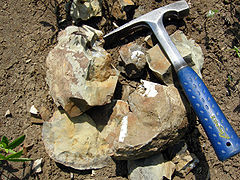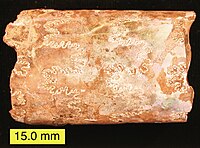| Pierre Shale | |
|---|---|
| Stratigraphic range: Campanian-Maastrichtian | |
 | |
| Type | Geological formation |
| Sub-units | From oldest to youngest:[1]
|
| Underlies | Fox Hills Formation |
| Overlies | Niobrara Formation |
| Lithology | |
| Primary | Shale |
| Location | |
| Coordinates | 44°23′42″N 100°24′43″W / 44.395°N 100.412°W |
| Region | North America |
| Country | |
| Type section | |
| Named for | Fort Pierre |
| Named by | Meek & Hayden, 1862 |

The Pierre Shale is a geologic formation or series in the Upper Cretaceous which occurs east of the Rocky Mountains in the Great Plains, from Pembina Valley in Canada[2] to New Mexico.
The Pierre Shale was described by Meek and Hayden in 1862 in the Proceedings of the Academy of Sciences (Philadelphia). They described it as a dark-gray shale, fossiliferous, with veins and seams of gypsum, and concretions of iron oxide. The Pierre Shale is about 3,138 feet (956m) thick at the type locality. It overlies the Niobrara division and underlies the Fox Hills beds.[1] It was named for an occurrence near Fort Pierre on the Missouri River in South Dakota.[3]
The Pierre Shale is of marine origin and was deposited in the Western Interior Seaway. It is correlative with other marine shales that occur farther west, such as the Bearpaw Shale, Mancos Shale and the Lewis Shale.[4] It correlates with the Lea Park Formation in central Alberta.[5] The Pierre is overlain by marginal marine deposits of the Fox Hills Formation.
Most of the formation was deposited in the Campanian Age of the late Cretaceous. However, the discovery of fossils of Baculites baculus in the uppermost beds of the Pierre Shale in the Raton, New Mexico area show that deposition continued here into the early Maastrichtian.[6]
- ^ a b Gill, J. R.; Cobban, W. A.; Kier, P. M. (1966). "The Red Bird section of the Upper Cretaceous Pierre Shale in Wyoming". Professional Paper. doi:10.3133/pp393a. ISSN 2330-7102.
- ^ Canadian Fossil Discovery Centre. "All About Bruce". Archived from the original on 2014-11-06.
- ^ MacLachlan, M.E. (1976). "Lexicon of rock-stratigraphic units in Union, Colfax, Mora, and eastern Taos Counties, New Mexico" (PDF). New Mexico Geological Society Field Conference Series. 27: 205–215. Retrieved 14 October 2021.
- ^ Izett, G.A.; Cobban, W.A.; Gill, J.R. (1971). "The Pierre Shale near Kremmling, Colorado, and its correlation to the east and the west". United States Geological Survey Professional Paper. 684-A. doi:10.3133/pp684A.
- ^ Lexicon of Canadian Geologic Units. "Lea Park Formation". Archived from the original on 2013-02-21. Retrieved 2009-03-23.
- ^ Sealey, Paul L.; Lucas, Spencer G. (2019). "Baculites Baculus Meek and Hayden, 1861 (Earliest Maastrichtian) from the Uppermost Pierre Shale in the Raton basin of Northeastern New Mexico and its Significance" (PDF). New Mexico Geological Society Field Conference Series. 70: 73–80. Retrieved 4 September 2020.
© MMXXIII Rich X Search. We shall prevail. All rights reserved. Rich X Search


